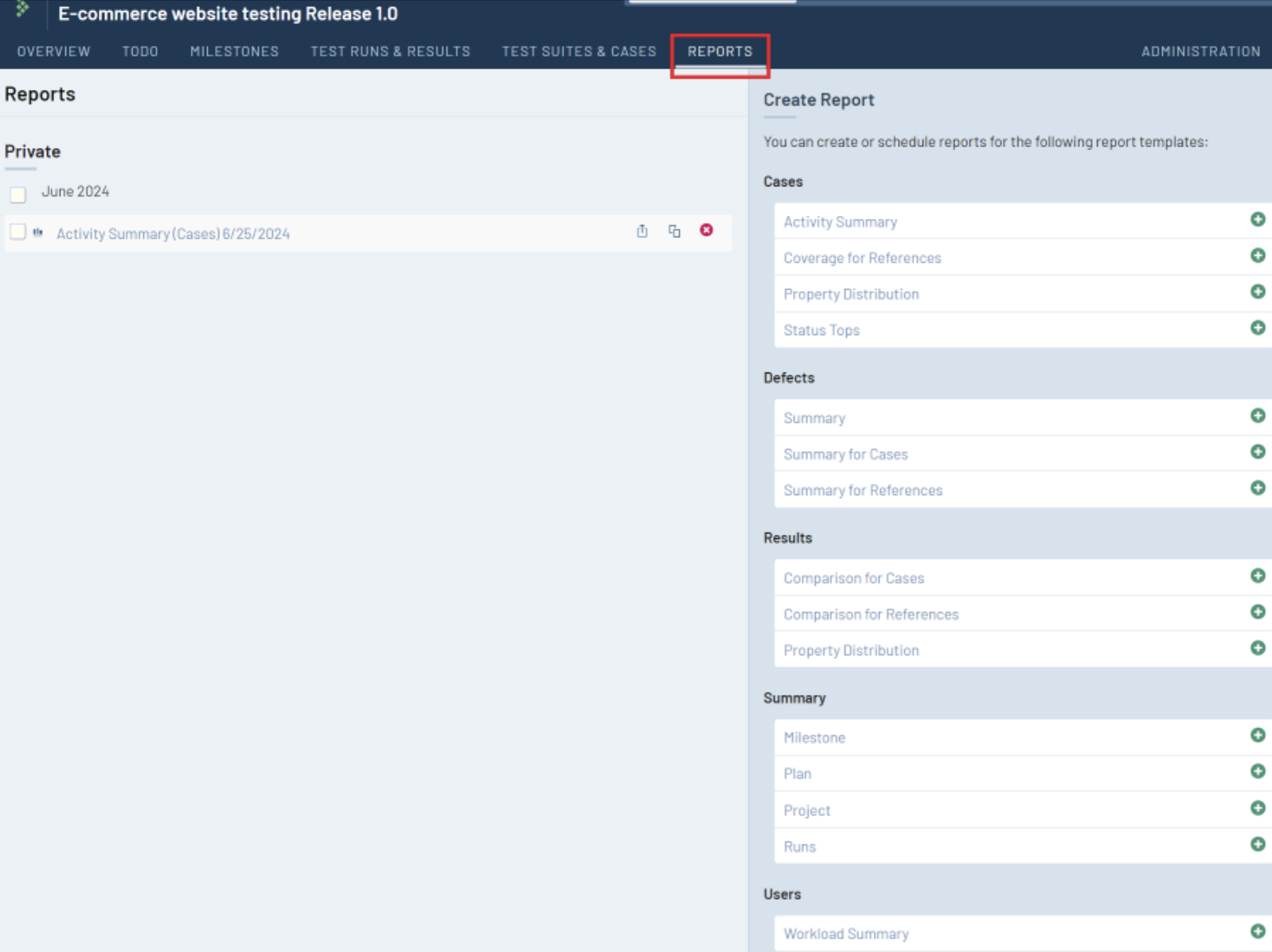
Software testing plays a critical role in delivering a top-notch software product. TestRail is a highly regarded test case management tool designed to manage the testing process for software development teams. This tool enables efficient management, organization, and tracking of software testing activities.
TestRail is known for its effectiveness and widespread use as a central repository for creating test cases, planning and executing test runs, and generating comprehensive reports. It seamlessly integrates with various automation testing, issue-tracking, and continuous integration tools to help you further.
In this article, we will walk through setting up a new project, test suite, test case, test run, and executing the test case. We will also review TestRail’s features with examples, its benefits of usage (with examples), and a few more use cases to provide absolute clarity.
TestRail Walkthrough
You can choose a trial version first and then move to a full-fledged account once you are accustomed to the tool. After you log in, you will see a Dashboard screen.
Create Project
Step 1: Here is the DASHBOARD, click ‘+ Add Project‘, under ADMINISTRATION to create a new project.
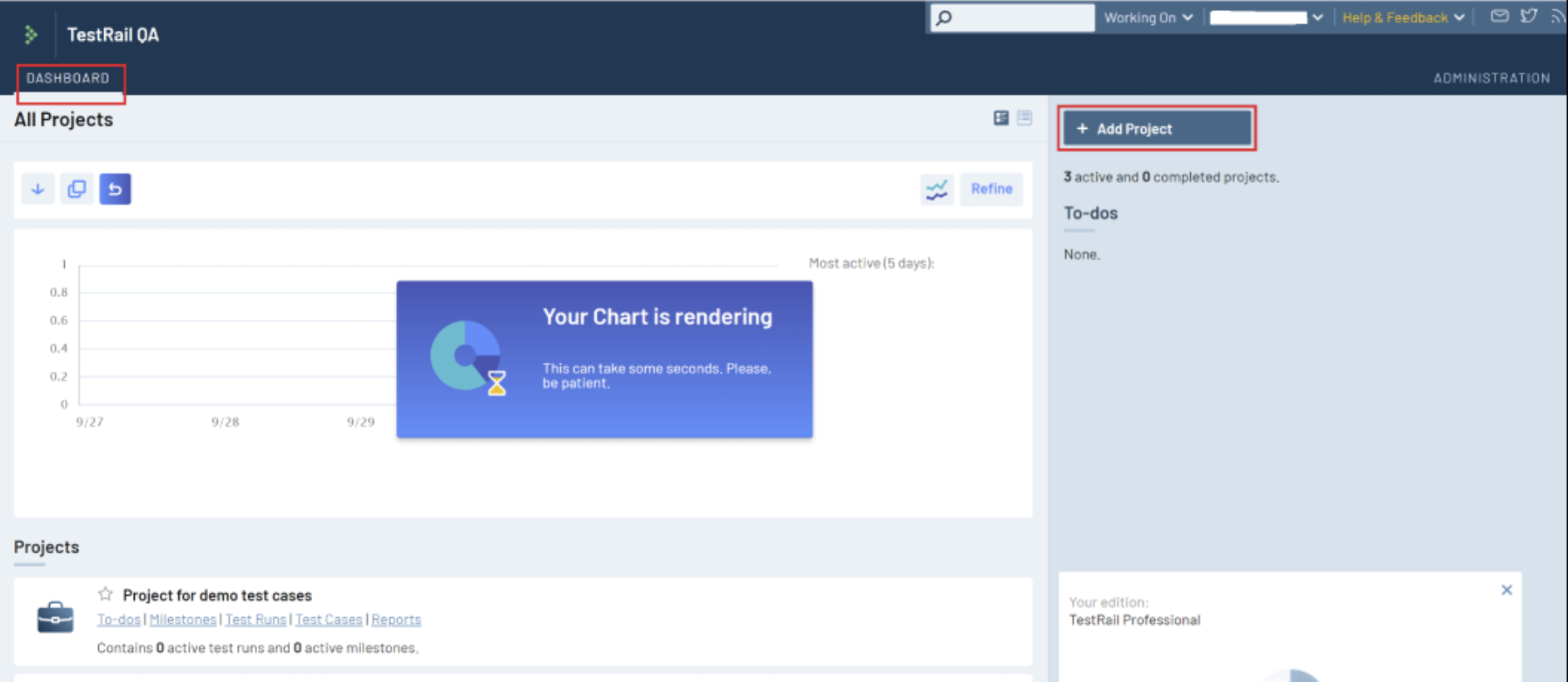
Step 2: Provide a project Name and select a repository type from three options. Then click Add Project.
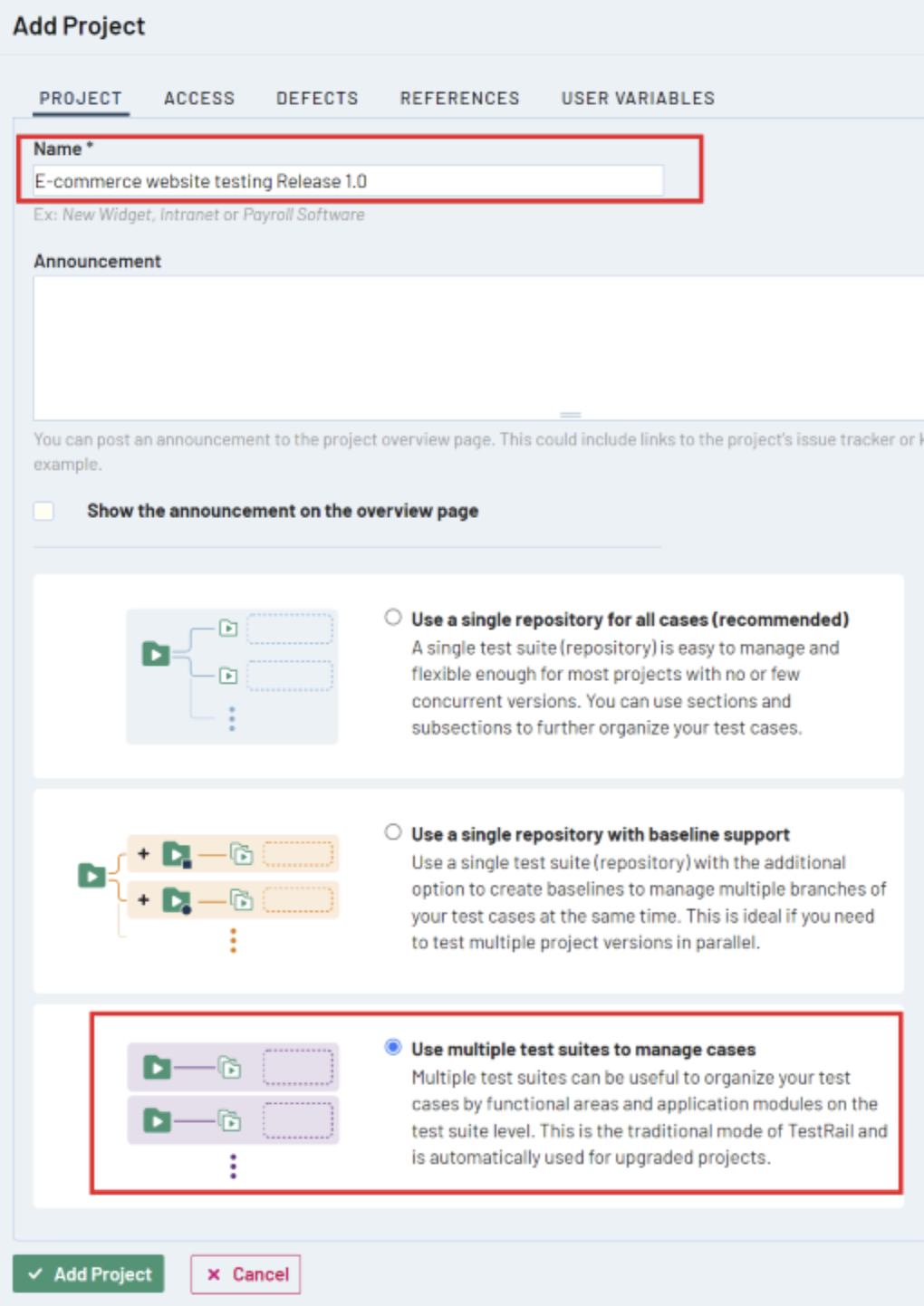
The project has been successfully added, and you will be able to navigate to the Dashboard to proceed to the next step.
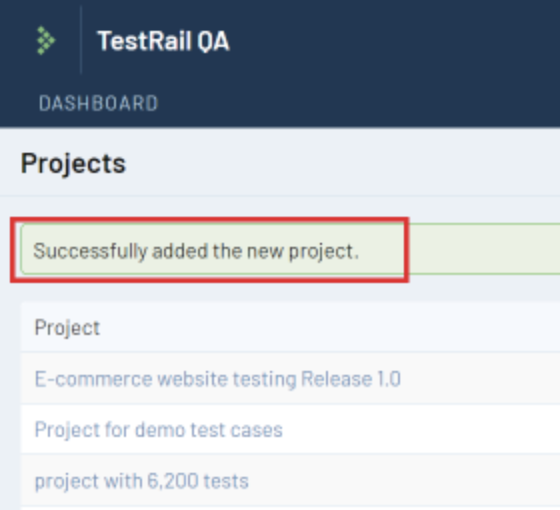
Add Test Suite
Step 1: Click on the DASHBOARD tab. You will see all existing projects. Under the newly created project name, click Test Suites.
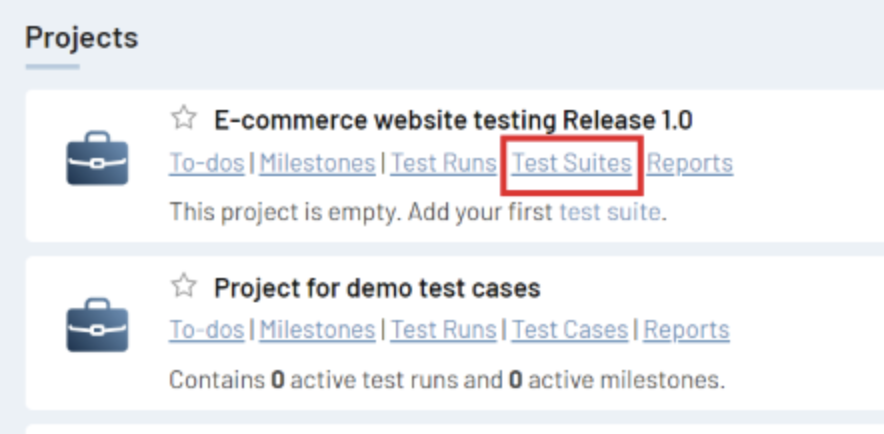
Step 2: You will be navigated to TEST SUITES & CASES tab, click ‘+ Add Test Suite‘.

Step 3: Provide a test suite Name, Description, and click Add Test Suite.
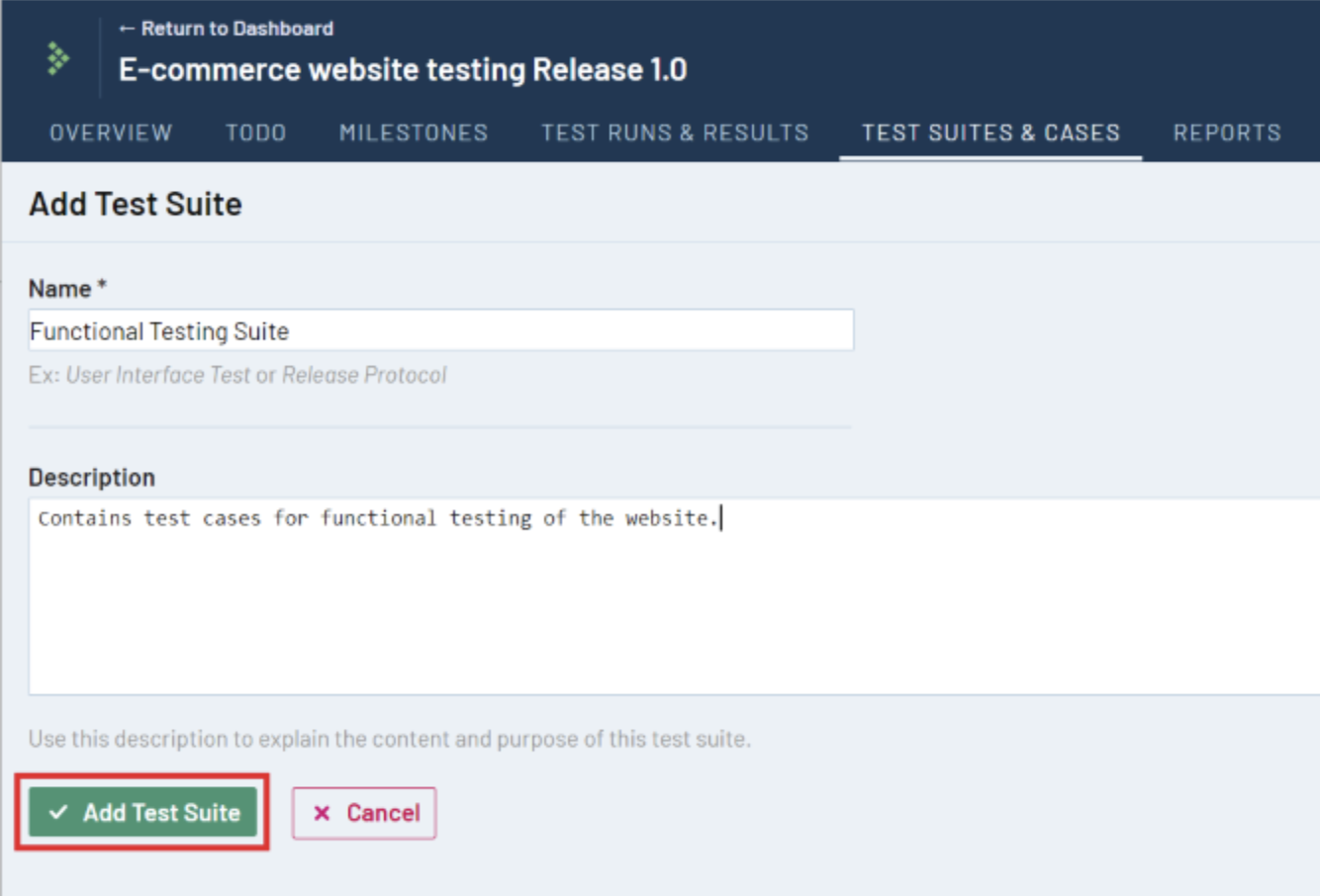
The test suite will be created.
Add Test Case
Step 1: The next step is to add test cases to this newly created test suite. Click ‘+ Add Test Case‘.
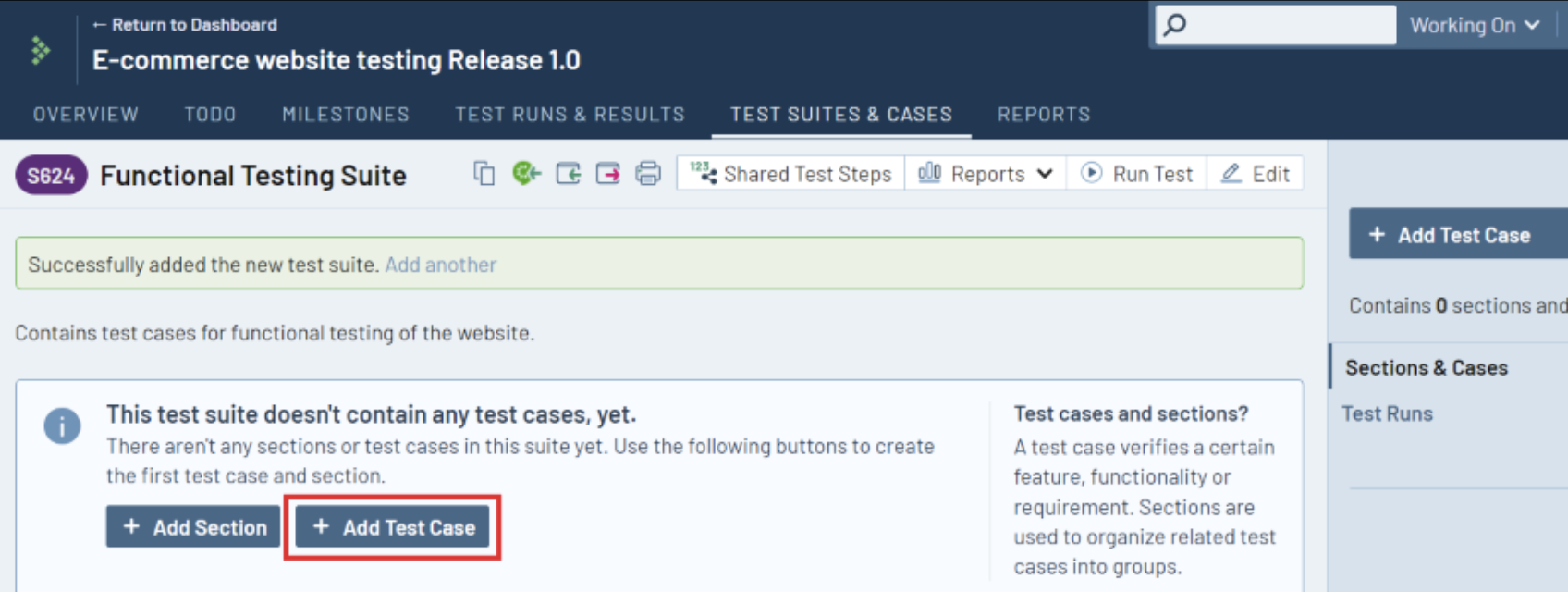
Step 2: Provide test case details as shown below:
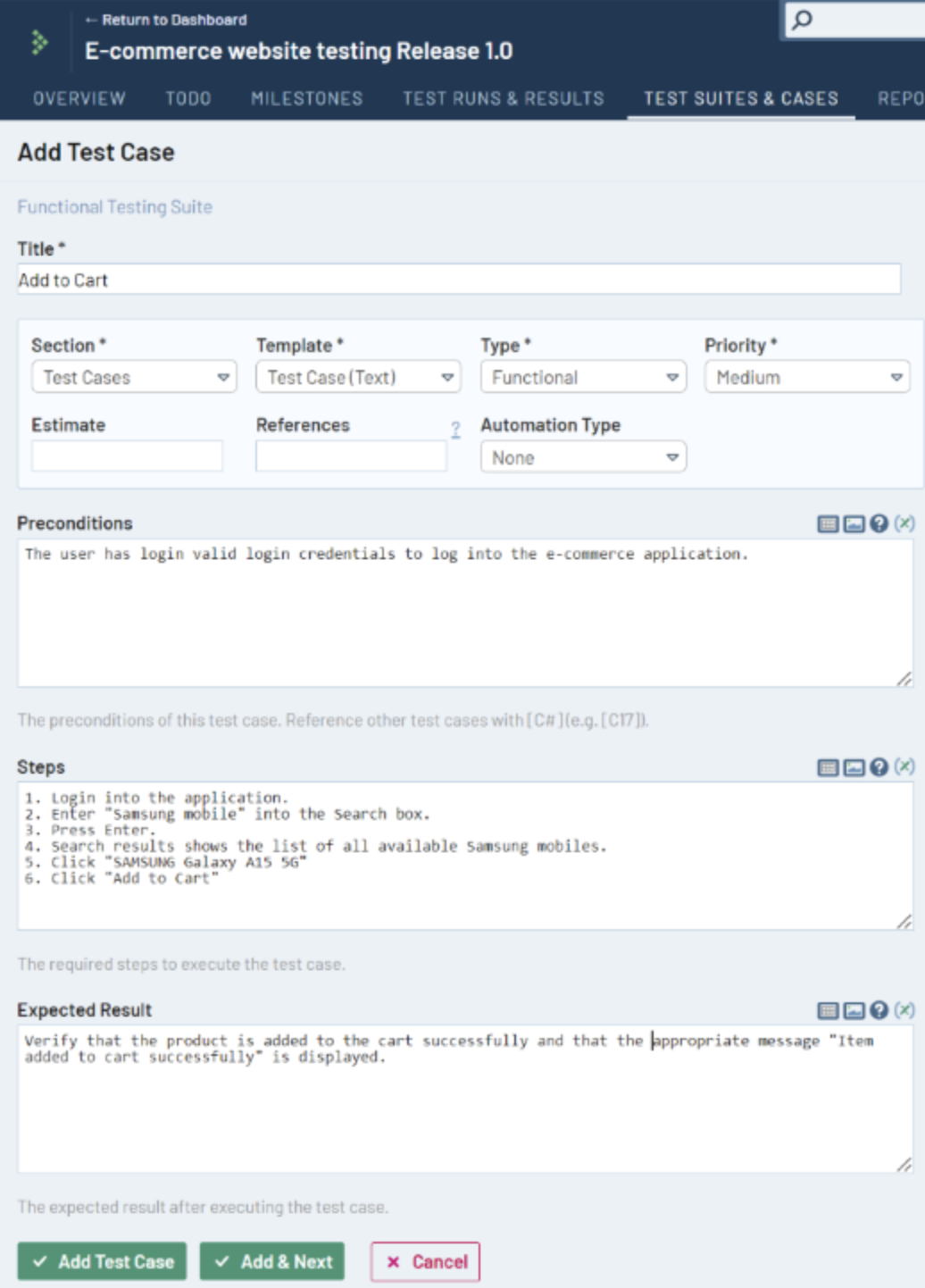
Step 3: Click Add Test Case, to add the new test case. You will see a message and newly added test case on the screen.
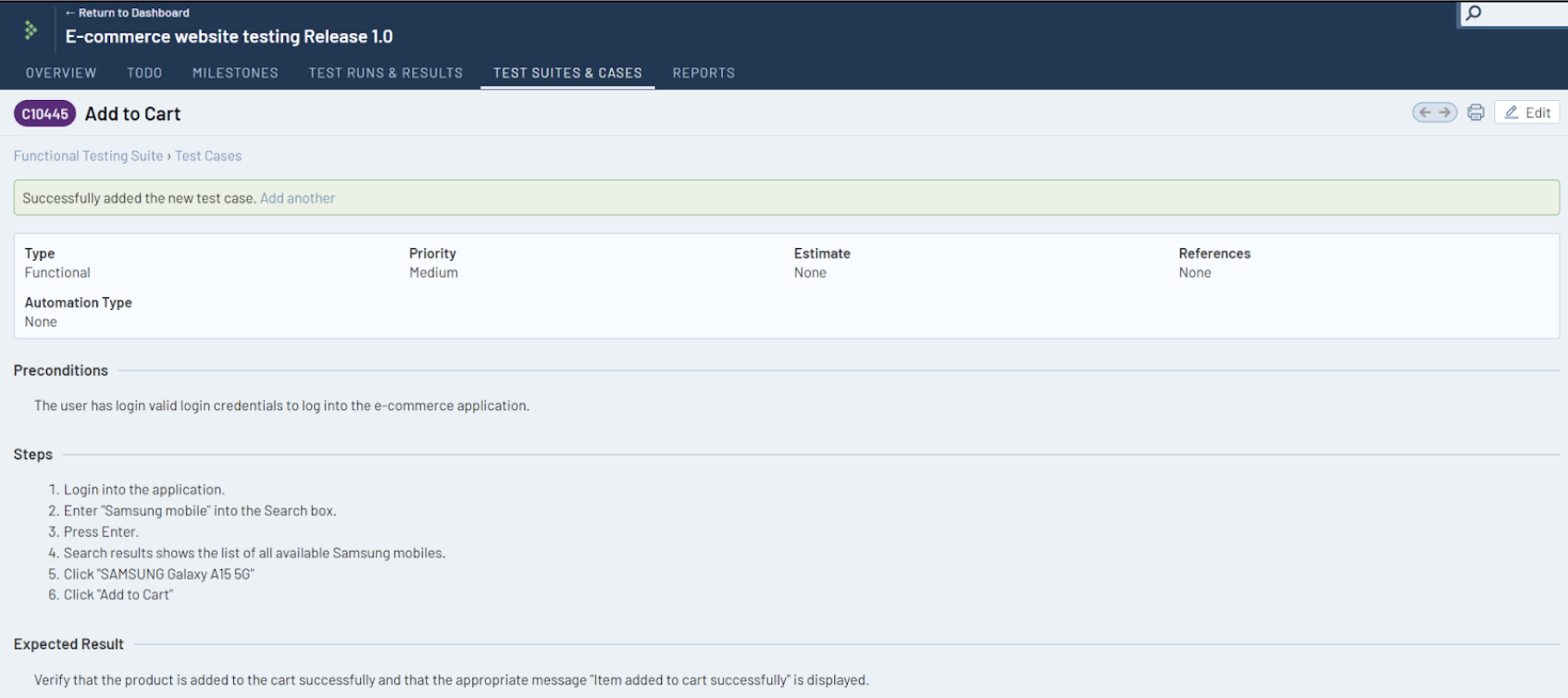
Now you can add more test cases to the test suite, as per the functional requirements.
Add Test Run
Once you have added all the test cases, you must first add a test run to start the test execution.
Step 1: Navigate to the TEST RUNS & RESULTS tab, and click ‘+ Add Test Run‘.
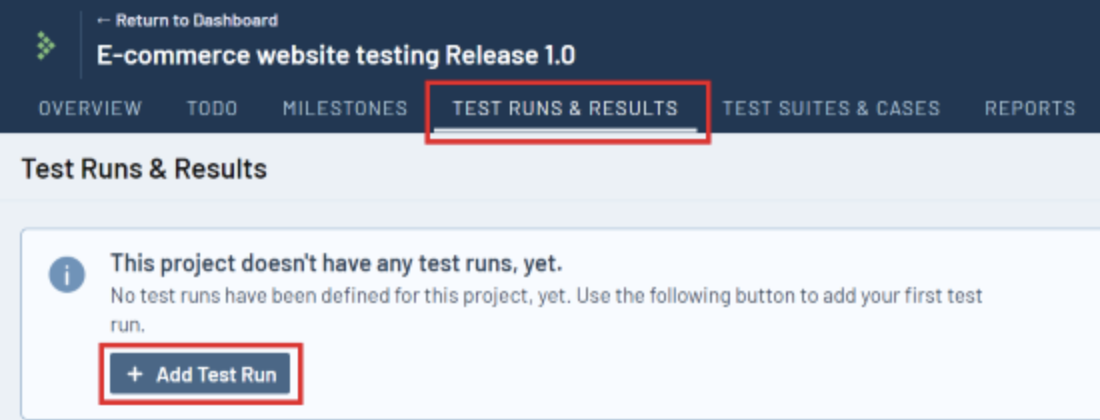
Step 2: Select the ‘Test Suite‘ for which you want to create a run and click OK. Then provide all the test run details. Select from three options: “Include all test cases”, “Select specific test cases”, “Dynamic Filtering” to select test cases. Click ‘+ Add Test Run‘.
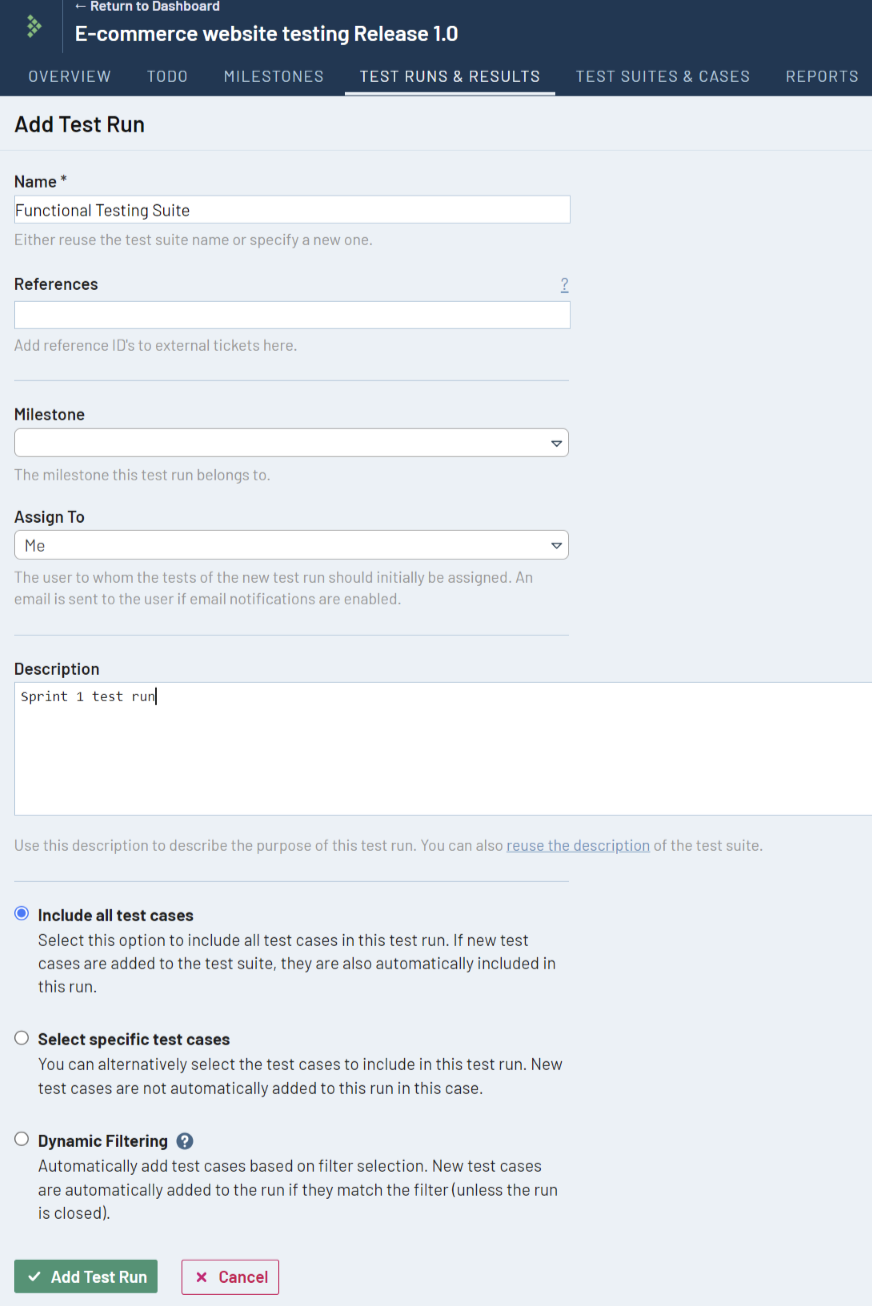
You will see below test run details on the screen, with test case details, status, user information, etc. Since, we have added only one test case, we are able to see details of a single test case.
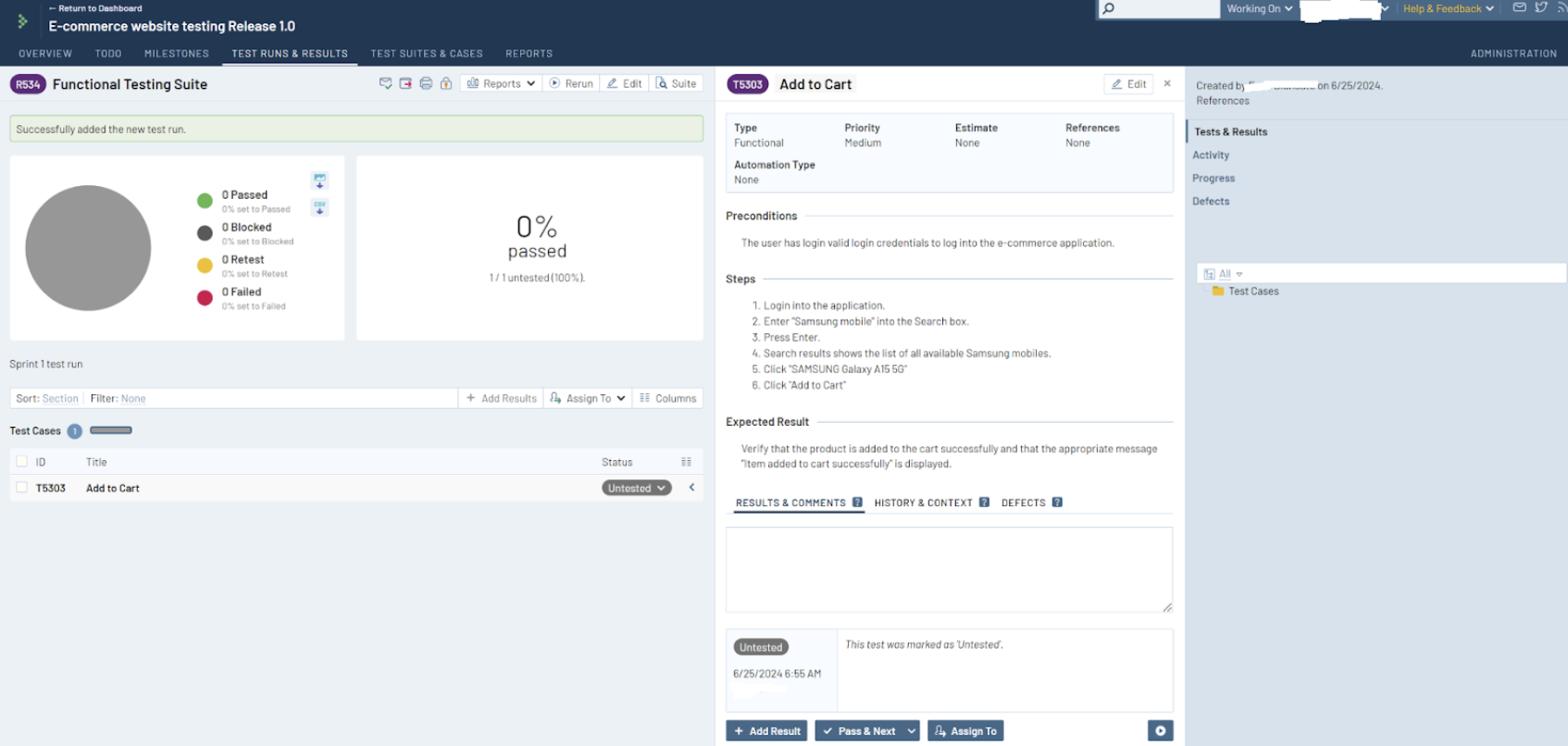
Add Test Case Result
The next step is to change the status of the test case to Pass, Fail, Blocked, or Retest after testing it. There are multiple options to do so. Use the ‘Add Result‘ button to add the test case result, or use the ‘Pass & Next‘ drop-down. You can also assign this test case to another team member through the ‘Assign To’ button. There is an option to provide ‘Results & Comments‘ in the text for better understanding.
For now, we will click ‘+ Add Result‘ and we will Pass the test case after adding comments and relevant files.
Click ‘Add Result‘.
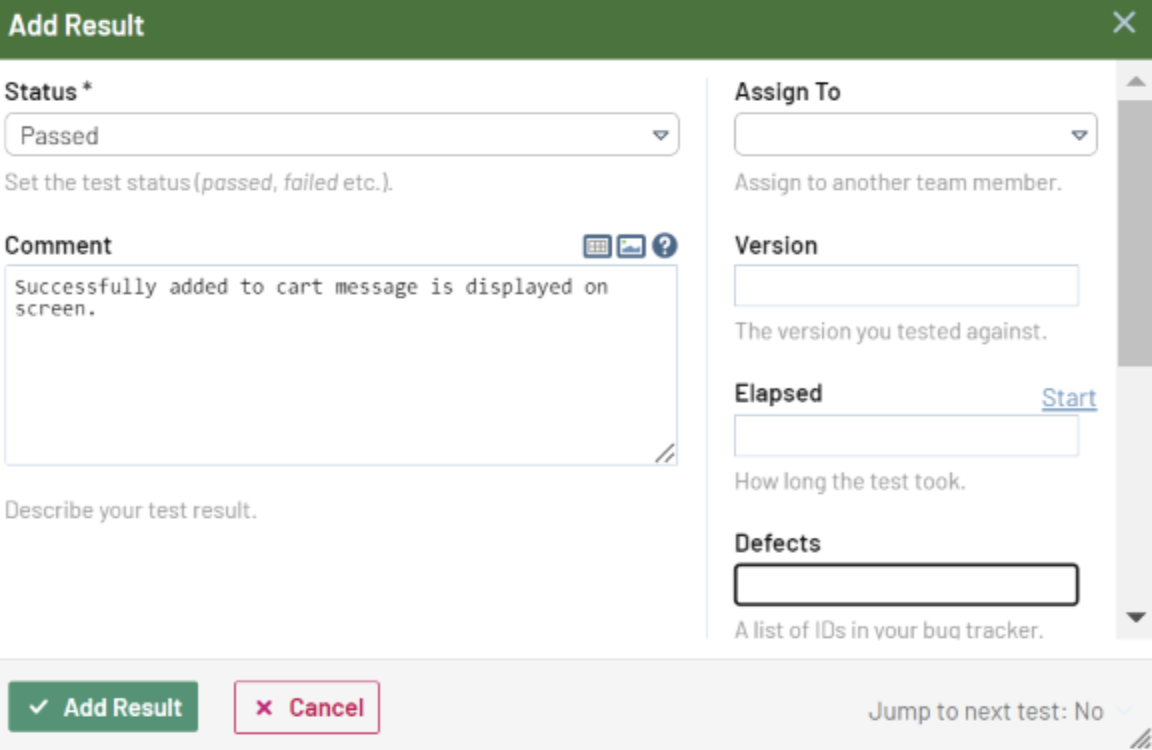
The test case is Passed, and the graph is updated accordingly.
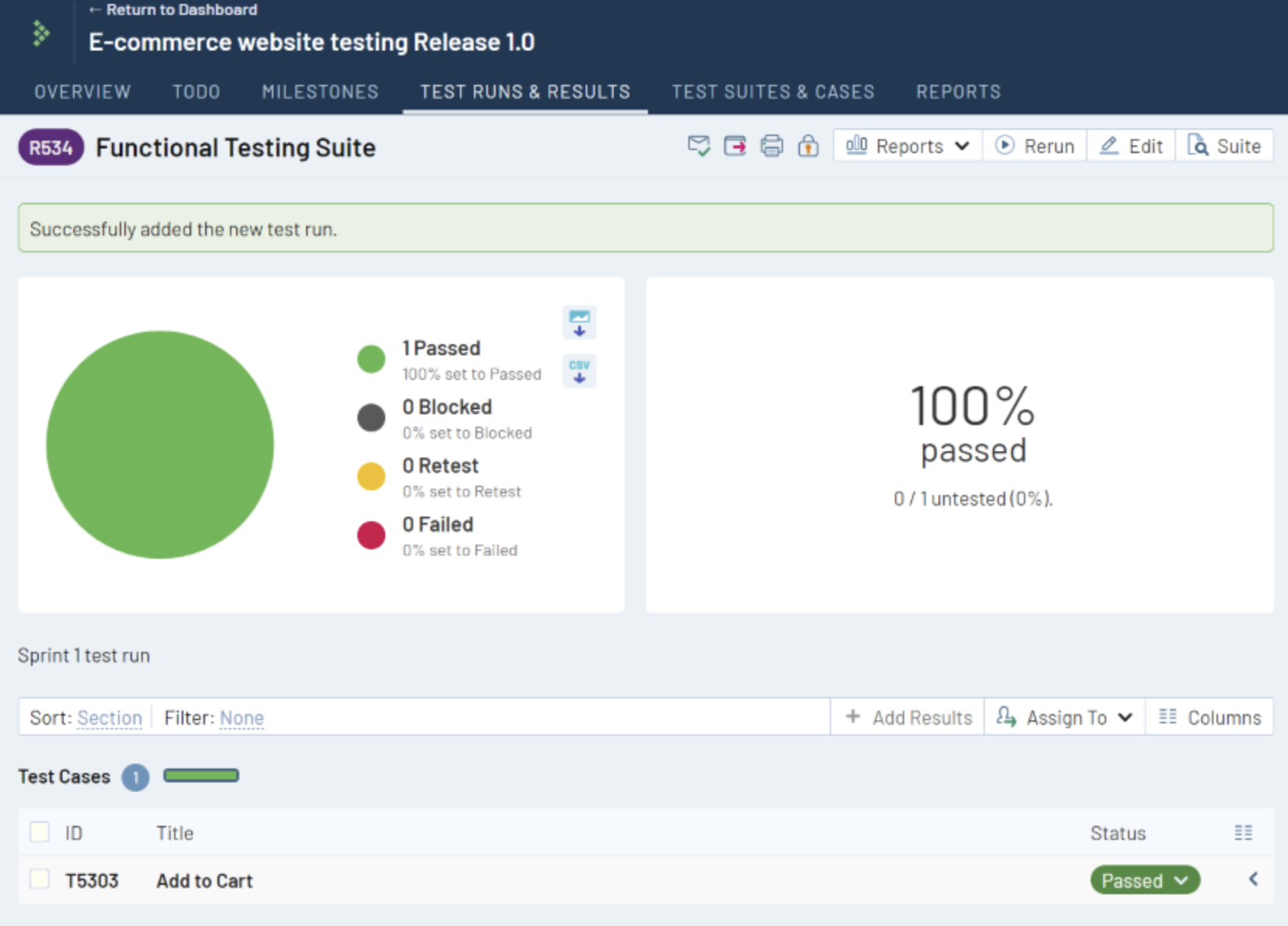
Tracking and Reports
For better tracking, you can use the ‘Reports’ tab and ‘Milestones’ tab.
-
Milestone: Add project milestones (such as software releases) to TestRail to manage and track multiple test runs for a single milestone, as shown below:
-
Reports: A report lets you generate statistics and charts for the data in your TestRail installation. Here are the various reports that you can generate:
Useful Features of TestRail
Let us review a few key features of TestRail that make it a great choice.
1. Test Case Management
- You can create, organize, and manage test cases and test suites.
- Test cases are organized into sections and sub-sections for easy organization.
Example: Let us take an example of a healthcare software company creating a new test suite for patient management. They organize test cases into sections such as “New Patient Registration,” “Create Appointment,” and “Medical Records Management.” You can add custom fields to track additional information like test priority and estimated execution time in TestRail.
2. Test Execution and Tracking
- Plan and execute test runs and test plans. Create a test plan that allows you to start multiple test runs at once for multiple configurations.
- When creating or editing test runs, there are multiple options for choosing the test cases to include: “Include all test cases”, “Select specific test cases”, “Dynamic Filtering”.
- You can define custom fields and templates to match specific testing requirements.
- You can create and run Behavior-Driven Development (BDD) scenarios using Gherkin syntax in TestRail.
- Track the progress of test executions in real time and record test results. This is one of TestRail’s most useful features.
Example: Let us consider a gaming company that schedules a test run for a new multiplayer feature. Test cases are assigned to different testers, who can execute them over a week. As each test case is run, testers record their results in TestRail, noting any failures or bugs. Managers can anytime track the overall progress in real time using TestRail’s dashboards.
3. Powerful Reporting
- Generate comprehensive reports on test progress, results, and coverage.
- You can find these reports by clicking REPORTS on the top navigation bar.
- You can generate Cases, Defects, Results, and Summary reports easily. For example, ‘Cases – Activity Summary‘ shows a summary of new and updated cases. This way you can view customized reporting based on your requirement.
- You can view key metrics and trends through charts and graphs.
Example: Let assume a financial services firm needs to report on the status of its quarterly testing efforts. They use TestRail to generate detailed reports showing test coverage, pass/fail rates, and defect trends. These reports are shared with stakeholders to provide visibility into testing progress and quality metrics.
4. Integration with Tools
- TestRail allows easy integration with popular issue-tracking systems like JIRA, Bugzilla, and Redmine.
- You can seamlessly connect with continuous integration tools such as Jenkins and Bamboo.
- It supports REST API for custom integrations and automation.
Example: A tech startup uses JIRA for issue tracking. They integrate TestRail with JIRA, allowing testers to create and link issues directly from test cases. When a test fails, a JIRA ticket is automatically generated with details from TestRail. This helps in seamless tracking and defect resolution.
5. Team Collaboration
- You can have team collaboration with comment threads and notifications.
- Easily assign test cases to specific team members and track their progress.
- You can manage user roles and permissions to control access and actions.
Example: A large enterprise development team is working on a new software release. Test cases are assigned to various team members across different locations. TestRail’s comment threads and notifications enable testers to discuss issues, share insights, and collaborate effectively despite geographical distances.
6. UI and Usability:
- TestRail has a user-friendly interface with intuitive design.
- Its customizable dashboard displays relevant project information.
- It supports multiple projects and teams within a single instance.
Example: Let us take an example of a small software development team. They customize its TestRail dashboard to display the most relevant information for its daily stand-ups. Widgets showing recent test results, open defects, and upcoming test runs are included. This customization helps the team stay focused on key metrics and tasks.
What are the Benefits of using TestRail?
TestRail offers numerous benefits that can significantly enhance the efficiency and effectiveness of software testing processes. Let’s explore these benefits in detail with examples:
1. Centralized Test Management
Benefit: You can use TestRail’s centralized platform for managing all test cases, test plans, and test runs. It ensures all testing activities are organized and accessible in one place.
Example: A large enterprise with multiple development teams working on different modules of a CRM system uses TestRail to manage their test cases. Each team can create and organize their test cases in separate test suites. But all test cases are stored in the same repository. This centralization ensures consistency, easy access, and better coordination across teams.
2. Improved Collaboration
Benefit: Increase collaboration among team members through comment threads, notifications, etc. There is a feature to assign test cases to specific testers.
Example: A globally distributed team is working on a new software release. TestRail allows testers to add comments and discuss issues directly within test cases. Notifications alert relevant team members when a comment is added or a test case is updated. This helps in real-time communication and collaboration eventhough they are in different time zones.
3. Real-Time Insights
Benefit: Use TestRail for real-time visibility into test progress, results, and key metrics through dashboards and reports. This helps to have quicker decision-making and issue resolution.
Example: During a critical product release, the QA manager uses TestRail’s dashboard to monitor the progress of test runs. The dashboard shows the number of tests passed, failed, and blocked, along with trends over time. Real-time insights help the manager identify bottlenecks and allocate resources more effectively. All these activities ensure timely testing completion.
4. Enhanced Quality
Benefit: TestRail can help you achieve thorough testing and better coverage, leading to higher-quality software releases. By organizing test cases systematically and tracking their execution, teams can identify gaps in testing and areas that need more focus.
Example: A healthcare software company developing an electronic medical records system uses TestRail to track their test coverage. They ensure that all critical functionalities, such as patient data entry, appointment scheduling, and medical history retrieval, are thoroughly tested. By maintaining detailed test cases and tracking their execution, the team ensures that the software meets quality standards and regulatory requirements.
5. Integration Capabilities
Benefit: TestRail seamlessly integrates with popular issue-tracking systems, continuous integration tools, and test automation frameworks and provides a smooth workflow.
Example: A development team using JIRA for issue tracking integrates it with TestRail. When a test case fails, TestRail automatically creates a JIRA ticket with detailed information about the failure. This integration ensures that defects are promptly reported and tracked, streamlining the defect management process. Additionally, the team uses Jenkins for continuous integration, and test results from Jenkins are automatically updated in TestRail. This provides a comprehensive view of both manual and automated test results.
6. Customizable and Scalable
Benefit: TestRail is highly customizable and scalable. It is suitable for teams of all sizes and adaptable to various testing methodologies, including Agile, Waterfall, and DevOps.
Example: A startup with a small development team customizes TestRail to fit their Agile methodology. They create custom fields for test cases to track story points and sprint assignments. As the startup grows and the team expands, TestRail scales with them together. This allows the addition of more projects, test cases, and users without any performance issues.
7. Comprehensive Reporting
Benefit: You can use TestRail’s reporting features for detailed insights into test progress, results, and quality metrics. This helps stakeholders and you make informed decisions.
Example: A financial services company needs to present testing progress and results to stakeholders at the end of each sprint. They use TestRail to generate reports that include test run summaries, pass/fail rates, and defect trends. These reports are shared with stakeholders, providing them with clear and comprehensive insights into the testing efforts and product quality.
8. Efficient Test Execution and Tracking
Benefit: TestRail allows for efficient planning, execution, and tracking of test runs and test plans. You can easily ensure that testing is thorough and organized.
Example: Before a major product release, a software company creates a test plan in TestRail that includes multiple test runs for different environments (e.g., staging, production). Each test run is assigned to specific testers, and their progress is tracked in real-time. This organization ensures that all necessary tests are executed, and any issues are promptly identified and addressed.
9. User-Friendly Interface
Benefit: TestRail’s user-friendly interface and intuitive design make it easy for team members to adopt and use the tool effectively.
Example: When a new tester joins a development team and quickly gets up to speed with TestRail due to its intuitive interface. The tester can easily navigate through test cases, execute tests, and log results without extensive training. This allows them to contribute to the testing efforts immediately.
10. Improved Test Coverage
Benefit: By systematically organizing and managing test cases, TestRail helps you achieve comprehensive test coverage. This reduces the risk of missed defects.
Example: A software company developing a new feature for their application uses TestRail to create test cases that cover all possible user scenarios, including edge cases. This systematic approach ensures that the feature is thoroughly tested and that potential defects are identified before the release.
TestRail Use Cases
Let us have a look at the popular use cases of TestRail:
-
Manual Testing: You can manage and execute manual test cases with detailed documentation and result tracking.Example: A team is developing a mobile banking application. They create detailed test cases in TestRail for various functionalities, such as logging in, transferring funds, checking account balances, and updating user information. Each test case includes step-by-step instructions and expected results. Testers execute these test cases manually, recording the results and any issues encountered directly in TestRail.
-
Automated Testing: Integrate with automation tools to schedule, and then you can track automated test runs.Example: An e-commerce company uses Selenium to automate its application tests. It creates automated test scripts to verify functionalities like search, add-to-cart, checkout, and payment processing. These scripts are integrated with TestRail using its API. After each automated test run, results are automatically updated in TestRail, providing a consolidated view of both manual and automated test results.
-
Regression Testing: You can easily organize and maintain a comprehensive suite of regression tests. This ensures stability with each release.Example: A software company releases frequent updates to its CRM system. They maintain a comprehensive suite of regression tests in TestRail, covering core functionalities that must not break with new releases. Before each release, they run the regression test suite, either manually or through automation, to ensure that existing features work as expected. TestRail helps track which test cases were executed, their results, and any regressions detected.
-
Continuous Integration/Continuous Deployment (CI/CD): Easily integrate with CI/CD pipelines to streamline testing as part of the development process.Example: A DevOps team uses Jenkins for its CI/CD pipeline. To streamline its testing process, the team integrates TestRail with Jenkins. Whenever a new build is triggered, Jenkins runs the automated test suite. The results are then pushed to TestRail, where they can be reviewed alongside manual test cases. This integration ensures that testing is a continuous part of the development cycle, helping to identify issues early and maintain software quality.
Another cool feature is if you have your manual test cases in TestRail and want to convert them to automated test cases in just a few clicks, you can import TestRail’s manual test cases into testRigor. This intelligent test automation tool lets you directly execute these manual test cases as automated tests with small tweaks using testRigor’s generative AI.
Conclusion
TestRail is a great test management tool to streamline how you manage and track your software testing efforts. It supports you to have smoother development cycles and higher-quality releases. TestRail suits teams of all sizes, and it can adapt to various testing methodologies, including Agile, Waterfall, and DevOps.
Its extensive and useful feature set and integration capabilities make it a valuable tool for improving the efficiency and effectiveness of software testing processes. You can use it to help your team create a testing ecosystem that is helpful to everyone, be it the development team, testing team, leadership, or any other stakeholder, for that matter.


